Vision: Healthy landscapes and soil managed for the future
The Land theme considers land health with a focus on agricultural land use.
The north central region has been extensively cleared for agriculture, particularly on the flatter more fertile plains, where less than 30% native vegetation remains (refer Biodiversity theme page for more information). Eighty seven per cent of land in the region is privately owned and much of it used for agriculture.
The region’s land managers are recognised as successful and innovative growers of food and fibre, who work hard to improve the condition of the natural resources on which they rely. Landcare was founded in the region in 1986 and there are now more than 160 Landcare and other sustainable farming groups active in the region.
The region comprises a variety of land and soil types that sustain a diverse range of agricultural enterprises. In the steeper terrain of the uplands, land is mostly used for livestock grazing, however further north in the gentler more undulating foothills of the Campaspe, Loddon, Avoca and Avon-Richardson river basins, cropping is common, alongside mixed farming enterprises. Irrigated agriculture is concentrated within the Goulburn Murray Irrigation District (GMID), in the north of the region on the Riverine Plains.
In the south east part of the region, predominantly south of Bendigo, the demographics continue to change with an increasing demand for rural residential living (lifestyle, hobby farm) development. With this expansion comes a wide range of landholders new to land management.
Whilst an ageing population and trend toward larger/corporate farms in the north and west is leading to population decline and associated socio-economic impacts including a reduced volunteer base.
Across the northern irrigation districts of the region, there has been significant change, driven by climate change, drought, irrigation modernisation, changing water policy, water trade out of the region and fluctuating commodity prices. This has reduced the amount of irrigation in the region and changed; the mix of irrigation enterprise types, irrigation businesses, surface and subsurface drainage requirements.
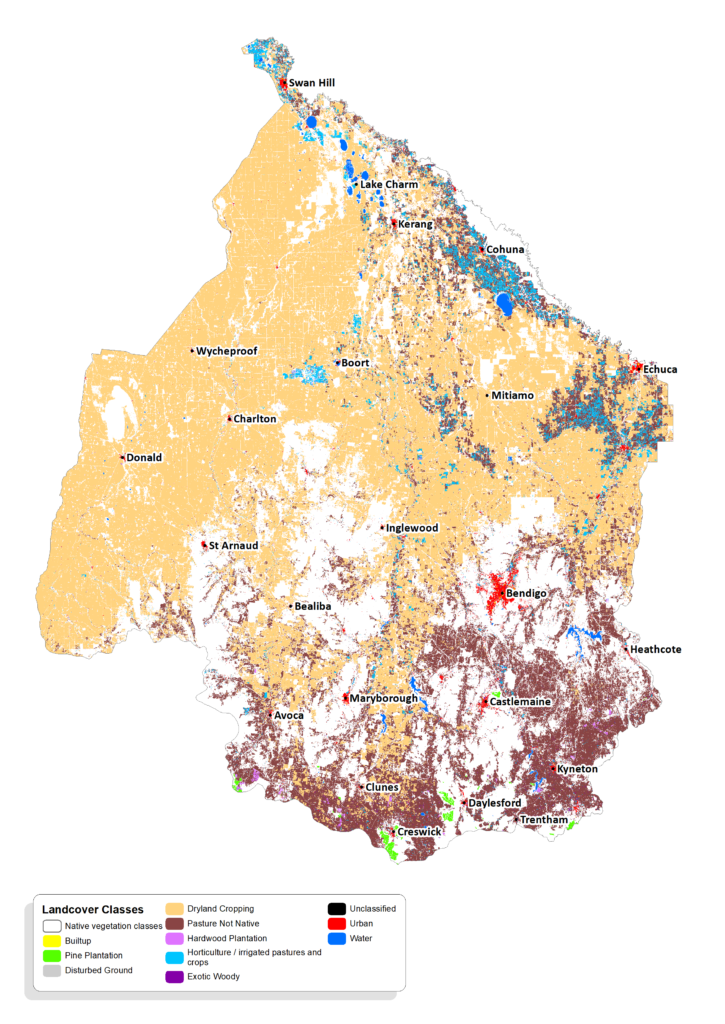
Changing demographics and land use and climate change bring considerable challenges but also opportunities.
The key approaches proposed to deliver on priorities for the Land theme are:
- Participatory community-based approaches that build capacity, empowering land managers/owners to make informed decisions.
- Supporting and recognising stewardship, and holistic land management for agricultural productivity and ecological values.
Assessment of current condition and trends
Land use
At a catchment scale, agricultural land use is commonly considered either from a dryland or an irrigation perspective. Irrigation is most common within the northern Riverine Plains comprising the lower reaches of the Campaspe and Loddon catchments and is largely based on the dairy industry, although horticulture is practised where soils are less sodic. The Harcourt apple industry along the foot-slopes of Leanganook (Mt Alexander), the potato industry in the rich red basaltic soils of the upper Loddon catchment and the stone fruit industry established on the lake lunettes of the Kerang area are other examples of irrigated horticulture in the region. Most water used for irrigation is sourced from reservoirs in the mountainous areas east of the region, however, a small but significant component is also drawn from regional and sub-regional aquifers, largely deep leads (ancient river gravels) and fractured rock aquifers.
Dryland farming is predominant wherever land is not irrigated or urbanised. Cattle and sheep grazing are common in the steeper uplands. Cereal cropping and grazing are common throughout the northern foothills and cereal cropping increases northwards into the Riverine Plains and onto the lighter Mallee lands of the north west.
The recently released Victorian Land Cover Time Series 1985-2019 show land use across the region, for broad classes and trends over time. The Extent of Land Uses graph below shows an increase in the dryland cropping area and a decline in pasture (not native) over the last 35 years. The breakdown of agricultural commodities reflects land use, with crops, livestock and livestock products contributing the most to overall gross value, as shown in the graph here. This data will be used to monitor future trends.
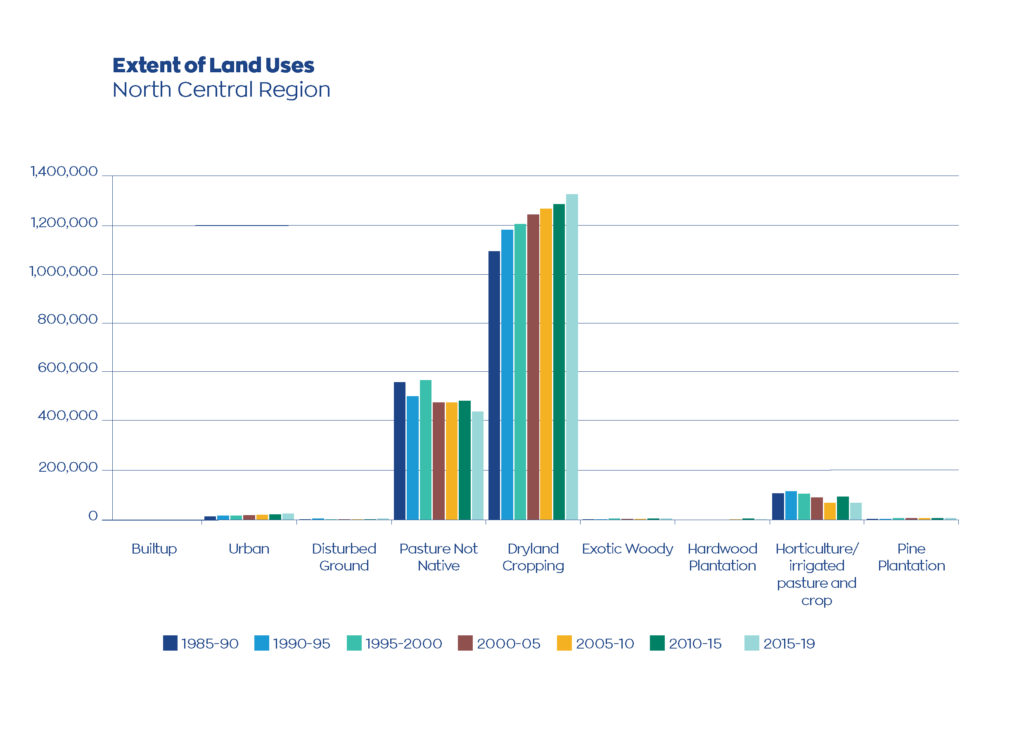
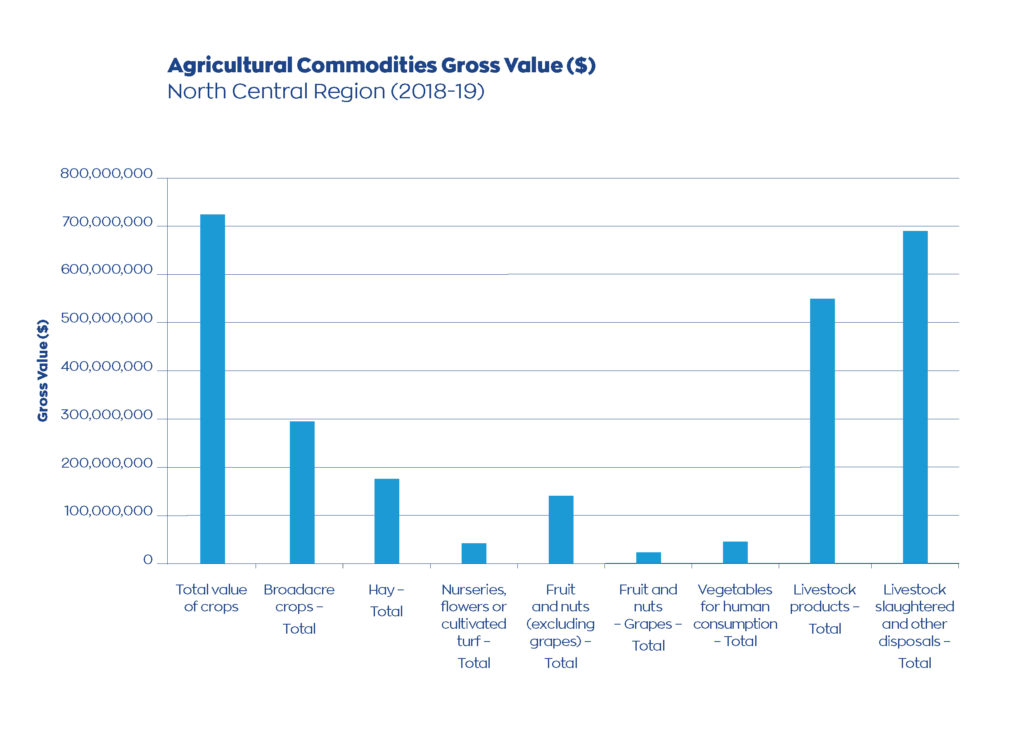
Soil health
Much has been achieved over the past decade, to slow the rate of soil loss and enhance the productive value of farmlands, through initiatives including conservation tillage, multi-species cover cropping and regenerative agriculture. Considerable challenges remain, however, in the quest for sustainable agriculture. Topsoil is still being depleted at an alarming rate. Seventy-five percent of the region has sodic subsoils which are sensitive to soil structure decline resulting from low levels of soil organic carbon. Declining soil structure impacts on soil quality and health leading to poor water-plant-soil relationships that retard root penetration and limit plant available water within subsoils.
Healthy water-plant-soil relationships are the foundation of healthy farming systems. This understanding is leading to innovations in soil management that recognise the role of soil organic carbon and soil biology in realising sustainable farming systems. Increasing soil organic carbon has considerable potential to improve resilience in the face of the transient climatic conditions now experienced throughout the region as extreme climate variability heralds the onset of climate change.
The soil landscapes map shown here is an aggregation of geomorphic units, considering geology, geomorphology, and relief which together, establish soil type. Understanding soil landscapes and their constraints, can inform our management responses, as outlined in the table below.
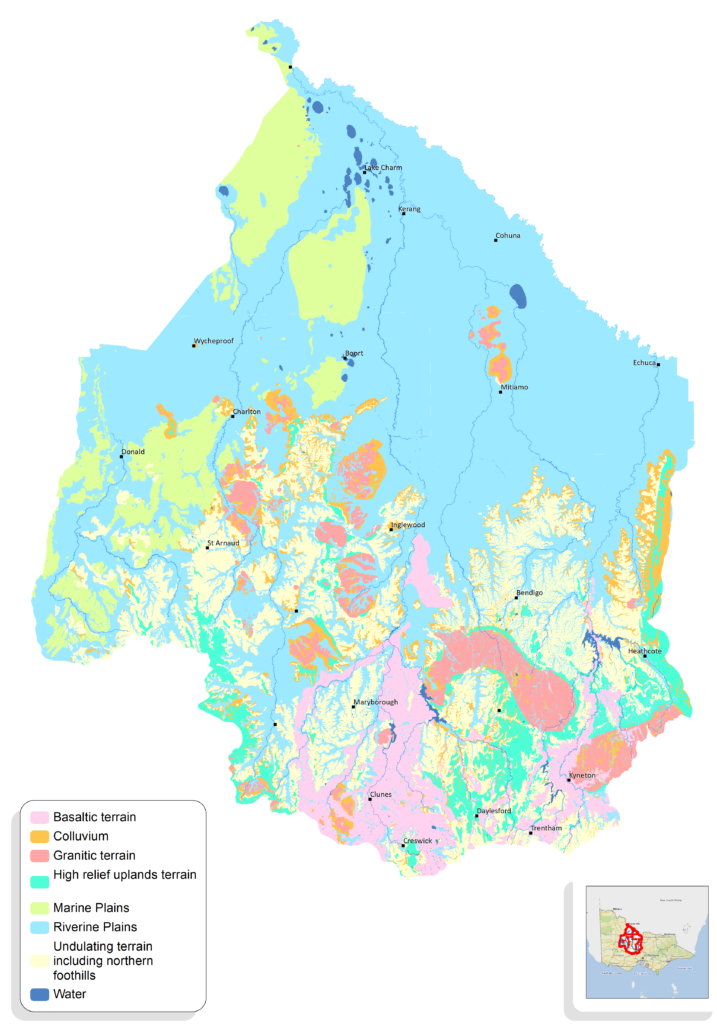
| Soil landscape | Issues | Management responses |
|---|---|---|
| High relief uplands terrain – steeper hilly terrain of the Great Dividing Ranges featuring prominent sandstone/slate ridges including metamorphic aureoles surrounding granitic intrusions. | Land degradation is prominent where excessive runoff induces gully erosion within adjacent valleys. This is exacerbated by excessive clearing of native vegetation, shallow soils with poor water holding capacity, and soil acidity with attendant aluminium toxicity. | Erosion control structures, land retirement, perennial agriculture, careful grazing management, revegetation and farm forestry. |
| Undulating terrain including northern foothills – gently undulating terrain of the northern foothills comprising intensely weathered metasedimentary rocks. | Dryland salinity can be very severe where salt stores are elevated in intensely weathered terrain. Salinity affects both farmland and water quality within streams. Soils sodicity is also commonplace and maintenance of soil structure remains an ongoing challenge. | Farming for sustainable soil management through the adoption of practices that include targeted farm forestry, saline agriculture, deep rooted perennial pastures, cover crops and conservation tillage. Adoption of erosion control structures can also be very important where gullies are severe. |
| Colluvium – unconsolidated sediments deposited as alluvial fans on the hillslopes of most terrain types found throughout the northern slopes and foothills of the Great Dividing Ranges. | Unconsolidated sediments deposited as alluvial fans on sloping terrain can be problematic from both a salinity and erosion perspectives given both surface water and groundwater processes are involved. The extent of issues depends, to a large extent on local hydrological conditions including the parent material from which colluvial aprons are formed. Dryland salinity and gully erosion are commonplace. | Colluvial aprons form within a wide variety of terrain types and, accordingly, management options are best devised through knowledge of local hydrological processes and geomorphic conditions. Options, however, will nearly always include opportunities for improving the water balance of farming systems. In some instances more targeted approaches include ‘break of slope farm forestry’ afford an effective and innovative approach. |
| Granitic terrain – includes all terrain types found in granitic lands ranging through (for example) the high relief terrain of the Mt. Alexander complex through to the intensely weathered low relief lands of Murphy’s Creek. | Gully erosion, soil acidity, silicified hard pans, and dryland salinity are all common in granitic terrain. Susceptibility to degrading processes is intimately linked to the physical nature of the terrain recognising a spectrum that extends from sandy outwash in steeper terrain through intense weathering in lower relief lands. | Management options must be tailored to local geomorphic circumstances. Options may include break of slope forestry, perennial agriculture, deep ripping, cover crops, manure injection and so on. Options must be linked to local hydrologic circumstances. |
| Basaltic terrain – Quaternary basalt flows that infill many of the larger valleys found throughout the mid to upper Campaspe and Loddon catchments. | Issues largely relate to soil structure which is generally excellent in the red soils and poor in the grey soils. Water logging frequently occurs in the latter. | Management options generally focus on opportunities to promote soil health through increased biological activity following the adoption of practices that increases soil organic matter. |
| Alluvial Floodplains – the vast alluvial plains extending northwards beyond the foothills of lower Loddon, Campaspe and Avoca catchments. Formed from unconsolidated sediments deposited by the present-day rivers and their ancestral streams. | Issues that require management for irrigated areas include the maintenance of soil structure, and salinity. The dryland areas are susceptible to the loss of soil structure associated with widespread occurrence of sodosols. The plains also suffer from dryland salinity. | Key principles and practices are established in a range of specific salinity management plans and consolidated in the recently renewed Loddon Campaspe Irrigation Region, Land and Water Management Plan (North Central CMA, 2020). The management of the dryland areas is largely concerned with attaining health soils through practices that sustain ground cover to avoid wind erosion and the adoption of practices that sustain or increase soil organic matter in an effort to retain and improve soil structure through soil biology. |
| Marine Plains – the gently undulating lands bordering the eastern Wimmera and Mallee country formed from marine sands deposited during the retreat of the Murray Sea | The lighter soils of the low rainfall lands in the west of the region are very prone to wind erosion | Practices that avoid wind erosion include the maintenance of soil cover in concert with minimum tillage and the maintenance of soil organic matter. |
Erosion
Percentage exposed soils is an important indicator of susceptibility to wind and water erosion. Generally speaking, >50% vegetation protects soil from wind erosion, and >70% vegetation cover protects soil from water erosion. Although with high rainfall, steep slopes or erodible soils greater than 70% cover is required.
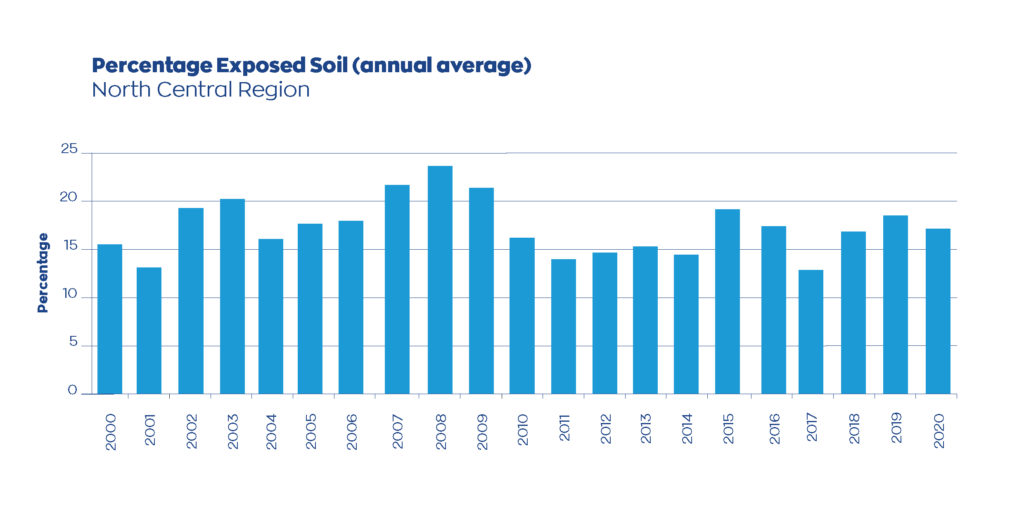
Erosion management is informed by local soils, terrain, climatic conditions and enterprise type. In many instances soil erosion has been mitigated in the region’s broadacre cropping areas through the adoption of conservation cropping techniques including minimum tillage, cover crops, the adoption of new farm machinery and the advent of precision agriculture, though dry conditions obviously make it more challenging to maintain cover. Refer table and map above, for information regarding soil landscapes and their susceptibility to different types of erosion. The graph here shows the annual average percentage of exposed soils for the region. This is a high level indicator, which can mask high levels of exposed soils over summer-autumn in some years. This indicator, along with more detailed information including percentage area protected from wind or water erosion and associated maps, and information from the Community Dustwatch program, will be monitored over time, to track condition and progress against related targets (refer Outcomes below).
Salinity
Salinity occurs throughout the north central region. In a few places it is natural, meaning it was there prior to colonisation, for example the salt lakes to the west of Donald. However, in most instances it is the result of changes in the hydrology of the land that can be attributed to the adoption of European agricultural practices. Increased recharge resulting from the (historical) clearance of native vegetation and irrigation ultimately led to an increase in groundwater discharge and the changes in the water balance bring salt previously stored below the land to the surface and degradation then occurs. The widespread occurrence of salinity around Kerang and Pyramid Hill is an example.
Salinity is not restricted to agricultural land, it is also a substantive issue in terms of the water quality of the region’s rivers and streams. Saltloads within the Axe Creek catchment southeast of Bendigo, for example, range from 5,000 tonnes per annum to more than 10,000 tonnes depending on seasonal climatic conditions. Salinity is also an issue in urban areas where it typically referred to as ‘urban salinity’. Where developments are proposed in close proximity to saline groundwater discharge local councils must give special consideration to the design of subdivisions ahead of their approval. Guidelines for subdivision design in saline areas have been produced and published by the North Central CMA and the City of Greater Bendigo.
The north central region, along with all other states and regions in the Murray Basin must comply within strict limits to the amount of salt permitted to enter the Murray River through the stream network. Procedures including reviews, audits and accounting are established under the Basin Salinity Management Strategy 2030.
Major threats and drivers of change
The over-riding issue for dryland farming enterprises, particularly in cropping areas, is soil structure. Economic imperatives continue to drive farming communities into traditional farming practices that have limited opportunity to sequester soil organic carbon. The lack of carbon limits the biology needed to build and retain soil structure, which is necessary to offset subsoil sodicity and salinity.
The over-riding issue for mixed irrigation enterprises is the affordability of water. Water charges represent a high proportion of income per megalitre and unless infrastructure is rationalised to more affordable levels, this industry will come under increasing pressure. Water pricing for example, may impact on horticultural industries. The industry is already at risk of increased crop failures resulting from variable/volatile growing conditions. Water pricing will be a factor influencing the industry’s capacity to meet increasingly specific and targeted quality assurance/market requirements.
Changing climate
Over the past two decades the region has witnessed extreme climate variability. The mid-1990s saw the onset of fundamental changes in rainfall patterns and water availability and these have prevailed through to the present. Within the new regime, extensive periods of drought are interspersed with extreme wet years with high rainfall events causing flooding. Over the past 30 years, average rainfall over the cooler months has declined and this is predicated to continue.
Climate adaptation is already happening on many levels – land managers and communities have been responding to the increased frequency of drought, flood and fire through a range of actions that minimise future risk. Farmers will need to continue to adapt, and be prepared for a range of scenarios. Development of practical place-based climate change resources that consider local conditions, land uses and multiple climate scenarios, to better inform adaptation has been identified as a priority direction.
Hotter, drier conditions and more intense extreme rainfall events are predicted under climate change which will increase the risk of erosion and loss of topsoil. Lighter textured soils in areas of higher relief that are susceptible to wind and water erosion, will be particularly vulnerable. Preventing overgrazing and maintaining groundcover will be important to protect soils. Increasing soil carbon will be important; as it not only captures carbon (mitigation), but also improves the overall health and adaptive capacity (ability to adapt) of soils.
Since the 1990s reduced rainfall has lessened the impact and threat of salinity as in many areas groundwater has receded in response to both reduced rainfall and a reduction in irrigated agriculture. Nevertheless, the threat remains and needs to be considered in future changes in land use and land management.
Land use change
Agricultural land use in the region is changing, largely in response to changes in market forces (including the water market), production costs and dry conditions. In cropping areas, increased mechanisation has led to farm aggregation and more corporate farms. In irrigation districts, drought; irrigation modernisation; changing water policy; and water trade out of the region have caused significant changes. The net effect has been a significant reduction in the amount of irrigation in the region (approximately 50% since the 1990s) and changes to the mix of irrigation enterprise types, irrigation businesses, surface and subsurface drainage requirements. This has and will continue to cause population decline in some rural communities, with knock on effects to the economy of local townships. Intensive agricultural enterprises (e.g. piggeries and poultry farms) are increasing in some areas. Land in transition is often not well managed for pest plants and animals, and new agricultural enterprises to the region, introduce new invasive species risks (e.g. almonds).
Clearing of native pastures, as a result of land use changes (grazing to cropping), including of threatened grassland communities that are protected by Federal legislation, continues to be a concern. Further mechanisation in cropping areas, is reportedly leading to further loss of paddock trees. A general lack of understanding or regard for legislation designed to protect biodiversity, as well as cultural heritage, has been identified as a concern across the region and this is reflected in priority directions on the Biodiversity and Traditional Owner pages.
RCSs are referred in the Victorian Planning Scheme. Local governments engaged to develop this RCS commented that the RCS does not currently provide sufficiently detailed guidance to inform planning decisions. More detailed information regarding erosion and salinity has been included in response to this. A priority direction has been identified to work with local and state governments to better align the RCS and Planning Schemes. In relation to strategic planning, several Councils indicated there was a need for up to date information to inform rural land use planning and manage development to protect values including productive agricultural land. As a result a priority direction to develop a regional land capability assessment has been identified to support this.
Engaging the changing demographic
Generally speaking, the ageing population and trend toward larger/corporate farms in the north and west of the region is leading to population decline and associated socio-economic impacts including a reduced volunteer base. Whilst in the south and east of the region there is strong growth in rural residential development which is increasing pressure on natural resources and introducing new landholders. Through engagement for RCS renewal we heard that:
- On the whole corporate agribusiness is not engaging in NRM programs or contributing to local communities. Given there is a growing number of corporate farms in the region, there is a need to address this, to influence land management practices and leverage support for local programs.
- The younger generation of farmers is more likely to leave the farm for a job in the city these days. With increasing land prices, young farmers who buy in, are very focused on business viability, so farm planning programs are likely to be of interest. Young farmers who inherit the family farm are not under the same pressure and may be more open to other types of NRM programs including new and emerging land management practices.
- New rural residential landholders often don’t have skills or knowledge in land management, a priority direction has been identified to deliver targeted programs to build capacity, like the Macedon Ranges Shire Council’s Sustainable Land Management program. Mentoring of new landholders by more experienced or retired farmers was also suggested through engagement for RCS renewal, like the Macedon Ranges program This farm needs a farmer.
Invasive species
Biosecurity and management of invasive pest plant and animal species across all land tenures continues to be important, with increased and new risks identified related to; climate change (species moving south as our climate warms) and land use change (land in transition not managed for pests, new industries in the region introduce new risks). Invasive species are an ongoing concern for government and private land managers, impacting on agricultural production and biodiversity. The Victorian Government’s approach is outlined in the Invasive Plants and Animals Policy Framework, which includes a risk-based approach to determine the most appropriate intervention to maximise public benefit, but also notes that community-led action and support, and the engagement of key stakeholders is essential to complement the roles of land and natural resource managers.
Opportunities
In order to respond to the challenges identified for the Land theme, it will be important to continue to build the resilience of agricultural enterprises to climate variability. Some land management practices that contribute to this include:
- Practices that increase soil organic carbon, have multiple benefits (including to sequester carbon), improve agricultural productivity and overall soil health. The amount of additional carbon that can be sequestered depends on the initial carbon content, the management practice, soil type and climate. For example, reduced tillage, the use of multi species cover crops and rotational grazing can build soil carbon.
- Revegetation on farm can: prevent erosion, provide shelter for livestock from adverse weather conditions, sequester carbon, and provide habitat for wildlife. Biodiverse and regenerative forestry can deliver multiple benefits too. The carbon market can be leveraged to support large-scale revegetation or regenerative forestry on farm. Refer to the opportunities and priority directions on the Biodiversity theme page for more information.
Regenerative Agriculture is a growing movement that incorporates these and other practices and is gaining traction amongst landholders.
Adoption of digital technologies will make an important contribution to building a more efficient, sustainable and productive agriculture sector. For example, remote sensors can collect data on key variables and relay to farmers quickly, providing greater insights into farm performance and improving decision making on farm.
It is acknowledged that new, creative and innovative solutions will be required as we adapt to our changing climate. Fostering partnerships with key research organisations, keeping abreast of evidence-based technologies and systems and supporting trail blazers will enable this.
Stewardship programs and community-based participatory programs are the key approaches proposed to deliver on priorities for the Land theme, as described below.
Stewardship
Catchment stewardship recognises the efforts of landholders who provide benefits beyond agricultural productivity, using best practice management to improve the condition of soils, waterways and biodiversity. Many of our region’s landholders are proud stewards of their land. Area under active stewardship is a policy indicator of interest to the state government. Development of a pilot stewardship program to recognise and support stewardship has been identified as a priority direction in this RCS – refer below.
The community-based participatory approach
Community-based participatory approaches have proven to be an effective way of building and increasing the adoption of new management practices. This involves supporting groups of landholders to work together and bringing in others to share skills and knowledge. The core principles of this approach are:
- Participatory and designed, as far as practical, to pass responsibility for NRM back to the regional communities that manage the land.
- Encompasses both public and private land and builds capacity and inclusion across the community.
- Encourages knowledge from different areas (e.g. government agencies, research organisations, traditional knowledge).
- Integrated and inclusive of sustainable agriculture, biodiversity, Traditional knowledge, productivity, and informed by a triple bottom line approach.
- Encourages peer learning and mentoring opportunities to support practice change
- Supports community well-being and connectedness.
Priority directions
Priority directions and outcomes were developed to respond to the challenges and opportunities identified, and to align with the state-wide RCS Outcomes Framework. We engaged key government partners to confirm delivery roles, and improve accountability for RCS implementation. The organisations identified as ‘key collaborators’ in the tables below, will be involved in initiating (including to source investment), but in order to succeed, partnerships, participation and support of many others is needed, including:
- Rural landholders, associated community-based NRM groups, volunteers and the broader community.
- Non-government organisations, industry and research organisations.
- Traditional Owners to speak for Country and participate/partner/lead (self-determination) in the delivery of RCS directions and outcomes.
| Priority directions | Key Collaborators |
| Deliver community-based participatory programs that build the capacity of land managers/holders, to improve land health. | CMA, Parks Vic |
| Design and pilot a holistic landholder stewardship program that measures improvements in land health, supports and recognises landholders efforts as improvements are made. | CMA, Ag Vic, DELWP |
| Continue to increase the skills and capacity of partners, service providers and land managers/holders to improve soil health. | Ag Vic, CMA, Parks Victoria |
| Collaborate to develop a soil health knowledge resource, to improve understanding of the potential and limitations of soils across the region, updating as needed to capture new knowledge gained through research. | CMA, Ag Vic, research organisations & universities |
| Develop and maintain: – up-to-date, geographically referenced land use information – consistent messaging to inform decision making around land use and system change. | CMA, Ag Vic, industry |
| Work together to develop place-based climate change resources for landholders and managers, to inform adaptation. | Ag Vic, CMA, DELWP, Water Corporations, key agricultural industry groups |
| Work with local and state governments to improve alignment of RCSs and Local Planning Schemes. | CMA, DELWP, Local Govt. |
| Undertake a land capability assessment of the region, considering values, constraints, and land use under multiple climate change scenarios, to inform land use planning and management. | CMA, Local Govt. |
| Continue to improve collective understanding of the latest evidence-based technologies and systems, support innovation and provide landholders with relevant and credible information. | Ag Vic, industry groups, farming systems groups and research organisations |
| Build stronger connections between on-ground needs and research activity. | Ag Vic, industry groups, research organisations, CMA |
| Deliver targeted programs to build the capacity of rural residential landholders, to protect and enhance soils, water and biodiversity values. | CMA, Ag Vic, Local Govt. |
| Identify drivers to better engage corporate agribusiness and leverage their support for local NRM programs. | CMA, Ag Vic, Landcare, key agricultural industry groups |
| Continue to increase the uptake of sustainable agricultural practices through implementation of the Regional Sustainable Agriculture Strategy, Soil Health Action Plan and Land and Water Management Plan for the Loddon Campaspe Irrigation Region (LCIR). | CMA, Ag Vic, GMW |
| Support a coordinated approach, to protect the region’s natural assets and agricultural industries from the introduction, establishment and spread of pest plants and animals. | CMA, Ag Vic, and public land managers |
Outcomes
| Long-term SMART outcomes | Key Collaborators |
| Improved management of irrigation and drainage systems, considering efficiency of water use and opportunities for ecological connectivity, by 2041. | Ag Vic, GMW, CMA, DELWP |
| Improved land health considering productivity, adaptive capacity and ecological function, by 2041. | Ag Vic, CMA |
| Medium-term SMART outcomes | Key Collaborators |
| Maintain an annual average percentage of no more than 20% exposed soils across the region, increasing area protected from wind and water erosion over dry months, by 2027. | Ag Vic, CMA |
| Increased uptake of improved soil management practices across 600,000 ha, to improve productivity, adaptive capacity and ecological function by 2027. | Ag Vic, CMA, Parks Vic |
| Engage 200 new rural landholders in community-based participatory programs, to build capacity by 2027. | CMA |
| 600 rural landholders in the LCIR adopting technologies and systems to improve agricultural productivity, water use efficiency and ecological connectivity by 2027. | Ag Vic, GMW, CMA |
The RCS Land Discussion Paper was drafted to frame conversations with stakeholders, obtain feedback and inform the development of this webpage. It includes more detail and references.


